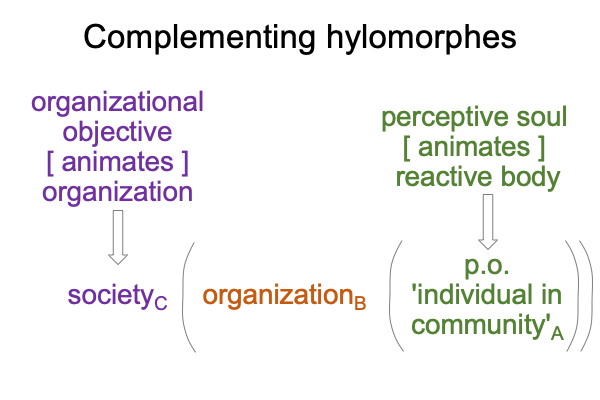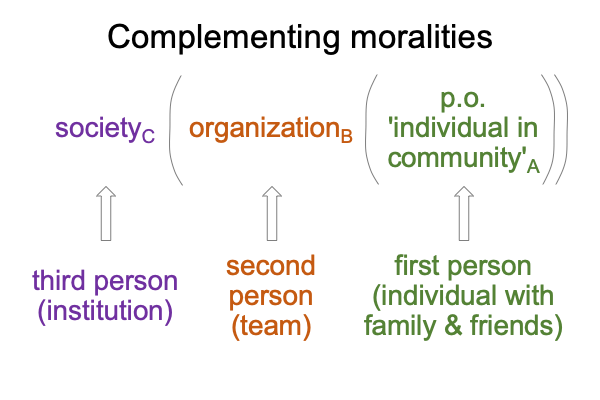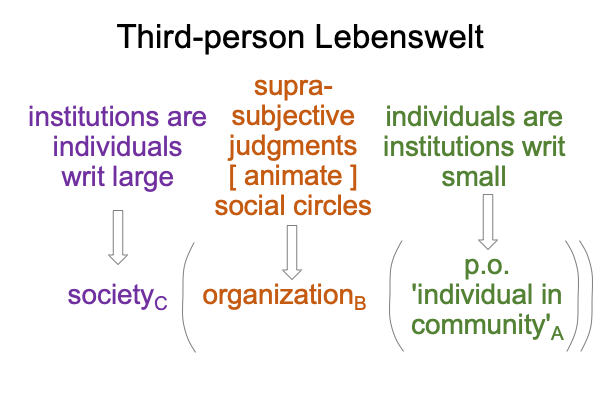0546 The previous blog not only demonstrates that Tomasello’s natural history of human morality ties back to the natural history of human thinking, the origins of social communication and the cultural origins of human cognition, but it also moves me closer to bringing the intersection for Era 2 into alignment with David Hume’s views of the nature of human morality.
How so?
0547 Recall the nested form that comes into being during the era of collective intentionality.

The perceptive soul [animates] reactive body2bA, or the perception2bA, characterizes the individual in communityA. An organizational object2aC, belonging to the content-level of an interscope corresponding to societyC, animates an organizationB by interpellating the individual in communityA and bringing the perceptive soul2bA into denkalignment.
0548 The institution is the third person of third-person morality.
You and me share intentions in joint attention in second-person morality.
You or me are the individuals in first-person morality.
0549 The institution goes with the societyC interscope.
You and me on the same team (or social circle) goes with an organizationB interscope.
You or me are humans who think in the way that the scholastics propose in the individual in communityA interscope.
0550 The interscopes of societyC, organizationB and individual in communityA belong to a primal category-based nested form, which is home to third-person morality.

0551 So, does perceptive soul [animates] reactive body2bA bring the individualA into organizationB?
Well, no, because denkalignment brings the perceptions2bA into alignment with an interpellation by an organizational objective2aC. Another way to say the actuality is, “The perceptive soul trains skills and emotions according to tradition.” Perceptions2bA characterize the individual in communityA.
Well, yes, get on board the denkalignment train.
0552 So, what brings the individualA into organizationB?
It must be a suprasubjective judgment2cA or “conviction2cA” emerging from (and situating) the possibility that a person is an institution writ small1cA in the normal context of making sense3cA.
0553 The following associations characterize the living-world of third-person morality.

0554 At this point, I may propose a loop whereby social circles adapt to one another in the Lebenswelt that we evolved in.
Society contains individuals writ large.
Today, we may call these individuals, “institutions”, but such a word cannot be fashioned in hand-talk or hand-speech talk. “Institution” is a purely symbolic label. “Institution” is an explicit abstraction. Hand-talk and hand-speech talk only facilitate implicit abstraction. So, our ancestors can not name institutions, not like the way that we do today.
For example, after a person dies, we bring the corpse to the tree of life.
Tree of life?
[IMAGE tree][POINT to breath while inhaling][POINT to sky and exhale]
A gathering to mourn is an institution.
0555 The individual writ largeC interpellates other individualsA.
IndividualsA denkalign with the interpellationC. In this, they serve as institutions writ small.
Individual convictions2cA animate each organizationB, each teamB, and each traditional manifestation of a social circleB.
Then, the events and processes of each organizationB, each teamB, and each traditionB are contextualized by an individual writ largeC. Such is the tree of life.
0556 Years later, the child of the deceased will say.
[NAME of deceased][IMAGE root][IMAGE tree][POINT to breath while inhaling][POINT to sky while exhaling]
